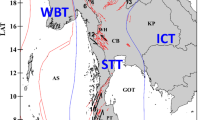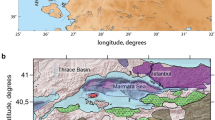Abstract
We present a P-wave minimum 1D velocity model for central and northern Pakistan along with station delays. The velocity model and appropriate station delays are obtained through travel time inversions as a solution of the coupled hypocenter location and velocity problem using the VELEST code. We used the arrival time observations at 25 stations of the Centre for Earthquake Studies (Islamabad) from 378 selected high quality local events with at least seven P-wave readings per event and an azimuthal gap < 180∘ from the period 2001 to 2020. The P-wave minimum 1D velocity model consists of eight layers with the depth up to 80 km. The P-wave velocity varies from 5.4 km/s at top layer up to 8.4 km/s at the bottom. The Moho boundary delineates the crust and mantle at the depth of around 50 km. The depth of the events is distributed from few kilometers up to 80 km. The station delays account for the local structure in the vicinity of the seismic station and vary between − 1.3 s and + 0.8 s. With the use of new 1D model there is significant improvement in RMS value and hypocentral parameters. Especially there is significant improvement in the depth. The model will be useful in high precision location of the local events and in filtering the data for outlier observations. The model may also be used as an initial reference model for 3D tomography.









Similar content being viewed by others
References
Bollinger L, Avouac JP, Cattin R, Pandey MR (2004) Stress buildup in the Himalaya. J Geophys Res Solid Earth 109(B11405)
Coward MP, Butler RWH (1985) Thrust tectonics and the deep structure of the Pakistan Himalaya. Geology 13(6):417–420
Crosson RS (1976) Crustal structure modeling of earthquake data: 1. Simultaneous least squares estimation of hypocenter and velocity parameters. J Geophys Res 1896-1977) 81(17):3036–3046
DeMets C, Gordon RG, Argus DF (2010) Geologically current plate motions. Geophys J Int 181(1):1–80
Gee ER, Gee DG (1989) Overview of the Geology and structure of the Salt Range, with observations on related areas of northern Pakistan. In: Tectonics of the western Himalayas. Geological Society of America
Husen S, Kissling E, Clinton JF (2011) Local and regional minimum 1D models for earthquake location and data quality assessment in complex tectonic regions: Application to Switzerland. Swiss J Geosci 104(3):455–469
Jaumé SC, Lillie RJ (1988) Mechanics of the Salt Range Potwar-Plateau, Pakistan: A fold-and-thrust belt underlain by evaporites. Tectonics 7(1):57–71
Kazmi A, Jan MQ (1997) Geology and tectonics of Pakistan. Graphic Publishers, Karachi, Pakistan, p 554
Kazmi A, Rana RA (1982) Tectonic Map of Pakistan 1:2 000 000, Map showing structural features and tectonic stages in Pakistan. Geological Survey of Pakistan
Kissling E (1988) Geotomography with local earthquakes. Rev Geophys 26(4):659–698
Kissling E, Ellsworth WL, Eberhart-Phillips D, Kradolfer U (1994) Initial reference models in local earthquake tomography. J Geophys Res Solid Earth 99(B10):19635–19646
Kissling E, Solarino S, Cattaneo M (1995) Improved seismic velocity reference model from local earthquake data in Northwestern Italy. Terra Nova 7(5):528–534
Koulakov I, Sobolev SV (2006) A tomographic image of Indian Lithosphere break-off beneath the Pamir–Hindu Kush region. Geophys J Int 164(2):425–440
Kufner S-K, Schurr B, Sippl C, Yuan X, Ratschbacher L, Ischuk A, Murodkulov S, Schneider F, Mechie J, Tilmann F et al (2016) Deep India meets deep asia: Lithosphere indentation, delamination and break–off under pamir and hindu kush (central Asia). Earth Planetry Sci Lett 435:171–184
Le Fort P (1975) Himalayas: the collided range. Present knowledge of the continental arc. Am J Sci 275(1):1–44
Lister G, Kenett B, Richards S, Forster M (1988) Boudinage of a streching slablet implicated in earthquakes beneath the Hindu Kush. Nat Geosci 1(3):196–201
Michelini A, Lomax A (2004) The effect of velocity structure errors on double difference earthquake locations. Geophys Res Lett 31(9)
Molnar P, Stock JM (2009) Slowing of India’s convergence with Eurasia since 20 Ma and its implications for Tibetan mantle dynamics. Tectonics 28(3)
Molnar P, Tapponnier P (1975) Cenozoic tectonics of Asia: effects of a continental collision. Science 189(4201):419–426
Ottemöller L, Voss P, Havskov J (2011) SEISAN Earthquake Analysis Software for Windows, Solaris, Linux and MacOSx. Dept. Earth Sci., Univ. Bergen, Bergen, Norway, 335
Pegler G (1998) Das An enhanced image of the Pamir–Hindu Kush seismic zone from relocated earthquake hypocentres. Geophys J Int 134(2):573–595
Rai SS, Priestley K, Gaur VK, Mitra S, Singh MP, Searle M (2006) Configuration of the Indian Moho beneath the NW Himalaya and Ladakh. Geophys Res Lett 33(15)
Sarwar G, Dejong K (1979) Arcs, oroclines, syntaxes: the curvatures of mountain belts in Pakistan. Geodynamics of Pakistan, edited by A. Farah and K. A. Dejong, Geological Survey of Pakistan, Quetta, pp 341–349
Sippl C, Schurr B, Yuan X, Mechie J, Schneider F, Gadoev M, Orunbaev S, Oimahmadov I, Haberland C, Abdybachaev U et al (2013) Geometry of the Pamir–Hindu Kush intermediate–depth earthquake zone from local seismic data. J Geophys Res Solid Earth 118 (4):1438–1457
Soomro RA, Hara T (2009) Receiver function analysis for crustal structure beneath Pakistan. Master thesis IISEE. Tsukuba, Japan
Tahirkheli RAK (1979) Geotectonic evolution of Kohistan. Geol Bull Univ Peshawar 11:113–130
Thurber CH (1992) Hypocenter-velocity structure coupling in local earthquake tomography. Phys Earth Planet In 75(1-3):55–62
Vinnik L, Singh A, Kiselev S, Kumar MR (2007) Upper mantle beneath foothills of the western Himalaya: subducted lithospheric slab or a keel of the Indian shield? Geophys J Int 171(3):1162–1171
Wessel P, Smith WH (1995) New Version of the generic mapping tools. Eos, Trans Am Geophys Union 76(33):329–329
Yeats RS, Lawrence RD (1984) Tectonics of the Himalayan thrust belt in northern Pakistan. In: Haq BU, Milliman JD (eds) Marine Geology and Oceanography of the Arabian Sea and Coastal Pakistan. Van Nostrand Reinhold, New York, pp 117–198
Acknowledgements
We are thankful to the staff of Centre for Earthquake Studies who helped in data preparation. We are very much thankful for the helpful review of Prof. Eddi Kissling, whose suggestions improved the overall quality of the paper. We are also thankful to an anonymous reviewer who also provided helpful suggestions. Most of the figures were made using the Generic Mapping Tools by Wessel and Smith (1995).
Author information
Authors and Affiliations
Corresponding author
Additional information
Publisher’s note
Springer Nature remains neutral with regard to jurisdictional claims in published maps and institutional affiliations.
Rights and permissions
Springer Nature or its licensor holds exclusive rights to this article under a publishing agreement with the author(s) or other rightsholder(s); author self-archiving of the accepted manuscript version of this article is solely governed by the terms of such publishing agreement and applicable law.
About this article
Cite this article
Soomro, R., Iqbal, S., Shah, M. et al. P-wave minimum 1D velocity model for central and northern Pakistan. J Seismol 26, 1039–1049 (2022). https://doi.org/10.1007/s10950-022-10111-x
Received:
Accepted:
Published:
Issue Date:
DOI: https://doi.org/10.1007/s10950-022-10111-x




